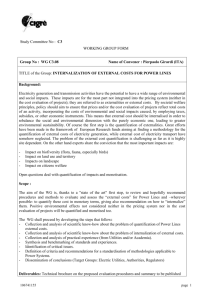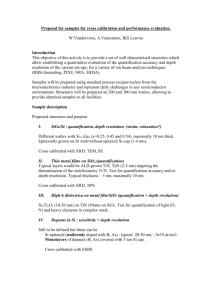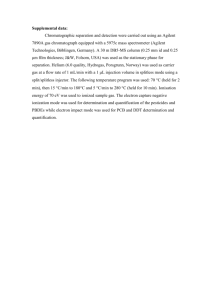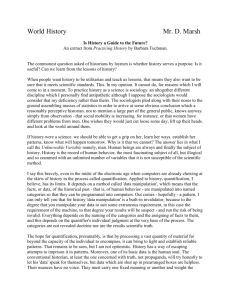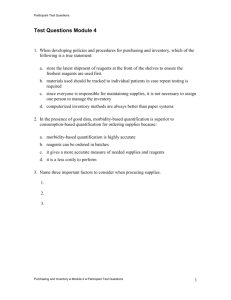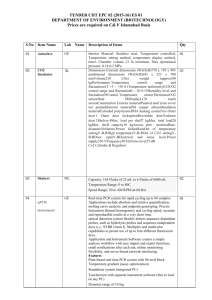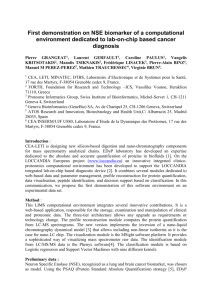Risk Quantification and Risk Management in Renewable Energy
advertisement
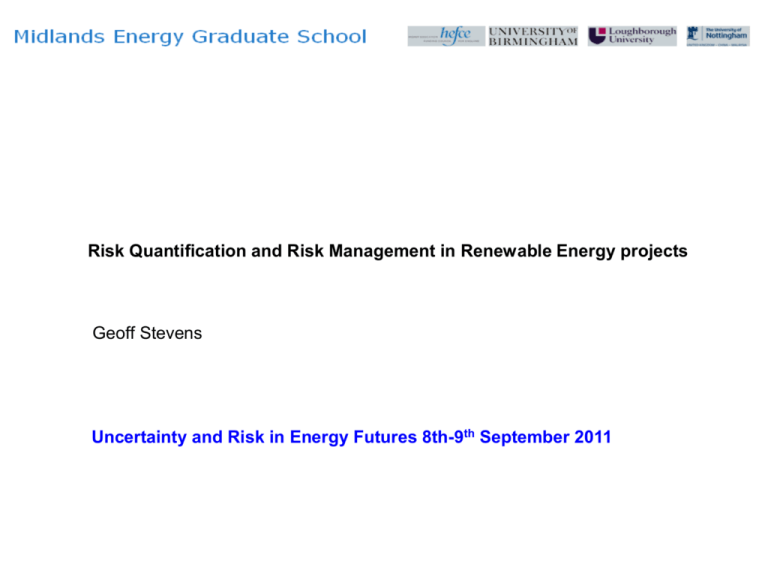
Risk Quantification and Risk Management in Renewable Energy projects Geoff Stevens Uncertainty and Risk in Energy Futures 8th-9th September 2011 Risk Quantification and Risk Management Introduction The title for this talk is taken from the IEA report on Risk Quantification and Risk Management in Renewable Energy Projects released in June this year You can find the report at http://www.iea-retd.org/files/RISK%20IEA-RETD%20(2011-6).pdf Rather than try to present this 150 page report in the short time available I propose to concentrate on the methods the report describes which deal with uncertainty and risk in future energy projects. I plan to focus on 1) Methods overall and especially those for risk identification 2) Shifts in risk perception for Renewable and Conventional energy projects 3) A case study for a pipeline illustrating the study output I hope to convince you the method offers a sound and practical approach Risk Quantification and Risk Management : Methods Overall The Risk Analyst needs to embrace many views of risk in a balanced approach The approach should 1. Embody independent judgement from the many perspectives of the various stakeholders associated with the project. As well as the Engineers involved this may include the Project Manager, the Business Sponsor, the Financier as well external Regulators and NGOs expressing minority interests. 2 Avoid the analysis being subverted either to justify narrow expert opinion or serve vested interests. 3. Recognise that any opinion about project uncertainties depends on -who you are (your background) -why you do the analysis (context) -when you do it (project definition) Risk Quantification and Risk Management: Methods Overall A systematic method is essential to manage the many aspects involved Starting from the project definition we take a 6 step approach which is iterative, allowing improved definition during the project life cycle. Past, present and future aspects are involved in a continuous learning process Risk Quantification and Risk Management: Methods Overall The approach can be implemented by combining workshops and modeling After collecting information to define the project and the needs of the analysis, a workshop is held to identify uncertainties. Evaluation of the risks as probability distributions informs a simulation model used for risk control in a second workshop Risk Quantification and Risk Management: Methods Overall A cyclical process can be developed incorporating key steps..... Revise model Parameters Workshop Rerun model with revised inputs Review the results and management options Risk Quantification and Risk Management : Methods Overall …...and the cycle can be repeated progressively through the project life 1 2 Range of Uncertainty 3 At the early stages of the project the assessment of risks is uncertain As the project is better defined the risks are assessed with more confidence Once the project is in progress risk controls reduce the residual risk still further Risk Quantification and Risk Management : Risk Identification Three methods are highlighted for identification depending on circumstances 1) Facilitated brainstorm Open outcry from the group, consolidation and cross check for coverage using the PEST framework 2) Checklist Using uncertainties from previous projects a checklist can be constructed using PEST to ensure balanced coverage of potential issues 3) Structured questioning (HAZOP) The main parameters (Flow, pressure, temperature etc) are combined with guidewords (high, low, no etc) to generate a list of questions which are applied to the project design Example of Technical Risk Breakdown developed in three levels using PEST Risk Quantification and Risk Management : Risk Identification Whichever method is chosen, the risk coverage is checked using PEST matrix Best practice for risk identification 1) ensures all key topics are considered 2) incorporates lessons learned from past projects Political Economic Social Environment Technical International National Regional The process is improved by A PEST analysis which helps to achieve a full coverage of risks and not become preoccupied with one risk area Local Site Individual M ature Ris k s 16 The use of a facilitated workshop drawing on a broad set of experience to develop an agreed list of project risks. The use of “risk libraries” derived from relevant projects as a checklist to prompt the identification process 14 12 10 8 6 4 T 2 S 0 E I N R Le ve l of Im pact P SS SC Ris k Type Risk Quantification and Risk Management : Risk Perception The types of uncertainties and issues raised shift as the project develops In the early feasibility stage or when Front End Engineering is underway uncertainties tend to be Political and Economic. Once in detailed engineering the focus narrows to technical aspects of the particular site or customer Risk Quantification and Risk Management : Risk Perception The maturity of the engineering is an important influence on perception of risk In the “pioneering“ phase dramatic cost overruns may occur. When a period of conservatism sets in, projects with inflated budgets can be delivered below estimate As the project engineering matures a more predictable regime can result Risk Quantification and Risk Management : Risk Perception Many factors combine to affect the risk perception of Renewable Energy projects Comparing Renewable Energy (LH column) and Conventional Energy (RH Column) projects - Many RE technologies are immature and may not deliver the design output/service factor - Integration of RE power output into conventional centralised energy grid/distribution - need for long term taxpayer subsidy and political support - Complex permitting if large land take and social opposition - immature supply chain with pinch-points for key equipment Risk Quantification and Risk Management : Pipeline example PIPELINE Case Study – Risk Identification Five workshops were conducted in four countries using expert teams from existing gas or energy supply companies. Each workshop followed the same steps, first defining and understanding the options, second brainstorming risks within the PEST framework and thirdly assessing the risks for use in a probabilistic DCF model. Risk Quantification and Risk Management : Pipeline example The results of the workshop exercise were recorded in a Risk Register A proforma allows project definition to be recorded, uncertainties to be itemised, their impact assessed and the range of opinion captured at the time of the assessment to provide input to the risk model and risk mitigation exercise Parameter affected Risk ID 17 Delivery risk Time between contract signing and gas shipment Units Representation years Base Case 4 years from date of signing to date of gas flow 1 0.8 0.6 0.4 Average 0.2 0 0.0 2.0 4.0 6.0 8.0 Parameter Value Sign Design and Construct Negotiation Less crude export Start Gas Operate 10.0 1 2 3 4 5 6 7 8 9 Min 0 3.5 Likely 1 3.9 Max 0 4.9 3.0 4.0 4.0 4.0 4.5 3.0 1.0 4.0 4.0 4.0 4.0 4.0 4.5 5.0 4.0 2.0 4.0 4.0 5.0 5.0 5.0 5.0 6.0 5.0 3.0 5.0 5.0 Abandon Explanation After contract signature within the sellers areas of responsibility will fall the construction and operation of the upstream facilities and the construction and operation of the pipeline. These may fall to different types of organisation. Please estimate if any difficulties may be experienced which cause unavoidable delay to the start of gas delivery after the date of signing of the supply agreement Difficulties include both genuine 'force maejure issues causing unavoidable delay for technical reasons as well as delays resulting from the technical competence of the contractor Risk Quantification and Risk Management : Pipeline example Uncertainties were grouped into categories and ranked by project impact In the workshops each team initially concentrated on Technical aspects but by use of the PEST framework a broader coverage of political and economic issues was achieved The 10 main categories of risk are shown below each of which was divided into more detailed concerns as illustrated for the first risk category. Risk Quantification and Risk Management: Pipeline example Two cycles of Risk Evaluation were carried out to consolidate viewpoints Because of the divergence of opinion across the five workshops, two review sessions were included in the study plan to allow consolidation and constructive challenge to the more extreme opinions Risk Quantification and Risk Management : Pipeline example The impact of each risk on the project DCF was simulated by Monte Carlo A probabilistic model was assembled based on a Discounted Cash Flow spreadsheet incorporating the assessment of risks made in the five workshops using suitable probability distributions Risk Quantification and Risk Management : Pipeline example The benefit of various Risk Control measures could be assessed with the model Several uses were made of the project model to explore approaches to improve the economics of the project. The first was to test the effect of increasing line capacity in various sections to assess the probability of failing to reach the pipeline capacity (and loose revenue) Risk Quantification and Risk Management: Pipeline example Crucial to pipeline economics is the tariff required to remunerate the investment The model was used to estimate tariff required to reach project hurdle rate. The additional tariff needed to reach a selected probability of achieving the hurdle rate was derived and this was used in market testing of the acceptability of the tariff. Risk Quantification and Risk Management Summary In this presentation I have tried to cover a lot of material in a limited time but still give Examples illustrating practical details The main points I have tried to make are 1) Risk Quantification and Risk Management require a multi-faceted, systematic approach. The temptation to pander to vested interests must be resisted. 2) There are three methods for risk identification suitable for different circumstances but each benefiting from a PEST crosscheck 3) The results of the analysis allow probabilistic analysis of the likely economic outcome of the project investment and provide a decision framework for improving risk management from the viewpoint of project sponsor, financier, constructor as well as the engineers and technologists trying to bring new technology to market
